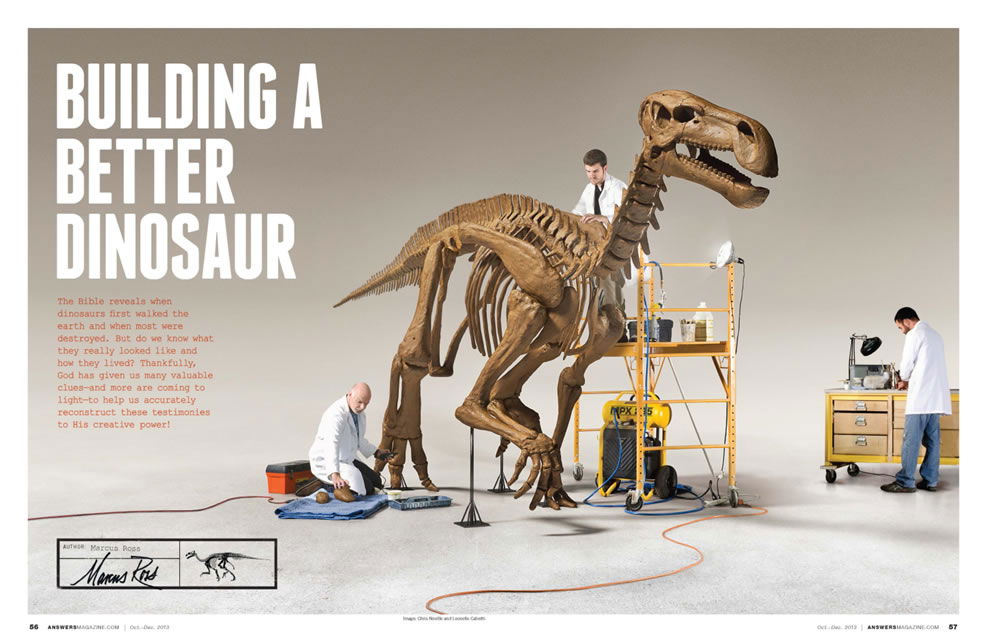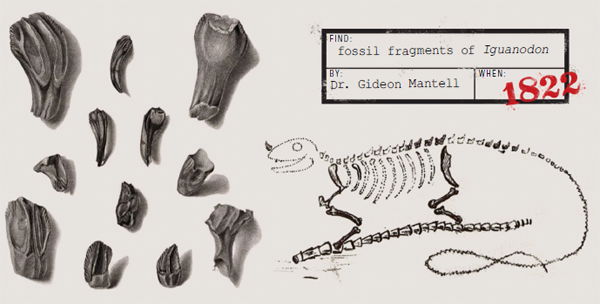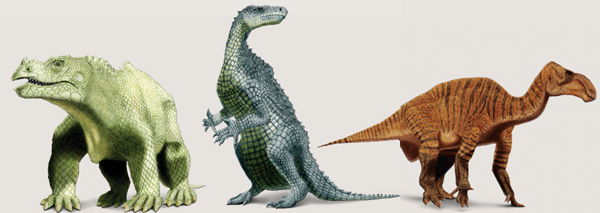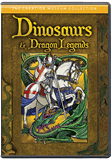Building a Better Dinosaur
The Bible reveals when dinosaurs first walked the earth and when most were destroyed. But do we know what they really looked like and how they lived? Thankfully, God has given us many valuable clues—and more are coming to light—to help us accurately reconstruct these testimonies to His creative power!
I love walking through the fossil halls of natural history museums, especially the older exhibits. There’s something majestic about those old dinosaur displays. If you look closely, you’ll often see thick iron bars and straps supporting the massive weight of the fossils, while other displays stick the bones in thick, yellow plaster backing, like a giant picture frame. These inelegant but effective displays speak to earlier times in paleontology.
Today we view these ponderous, tail-dragging reconstructions as a bit dated compared to the vivid and dynamic poses in modern exhibits, as sleek, fleet-footed creatures dash through three-dimensional scenes or tower over our heads in the exhibit halls. But do we really know that the newer versions reflect a better understanding of dinosaurs, or are they just the current fad?
Our certainty starts with the early chapters of God’s Word, where God describes making the great “beasts of the field” (a group in which dinosaurs definitely fit!) on Day Six of Creation Week. After that, our level of certainty drops, and quite quickly, too. That’s because while the Bible puts the dinosaurs’ creation in context, we are then left with only their Flood-formed fossils to tell us what they were and, with the help of a few other clues, how they behaved. We really want to “get our story straight” as much as possible! After all, the Creator specifically designed these creatures to give glory to Him, and we paleontologists now get to partake in it (Romans 1:20; Job 12:7–9). What an opportunity!
The best approach is to follow the clues left in stone. With each discovery of new clues, more light is shed on old ideas, testing their merit. A case study of one of the first dinosaurs ever discovered shows how paleontologists—like modern forensic scientists—can use even the slimmest clues to help them piece together the truth about extinct animals.

The First Clues—Comparative Anatomy
The first evidence was discovered in 1822 in Sussex, England. While her doctor husband was attending to a patient, Mary Ann Mantell found a loose group of fossils among road construction debris. Knowing her husband’s interest in the emerging science of paleontology, she brought them home for his evaluation. Dr. Gideon Mantell was fascinated, recognizing that the handful of large teeth and bone fragments were unlike those of any known animal, living or fossil.
Mantell conferred with the most prominent paleontologists and anatomists of his day to determine the fossils’ identity. His big break came after he observed a skeleton of a modern iguana, when he recognized striking similarities between the teeth of this plant-eating lizard and his fossils. Using comparative anatomy to interpret these first clues, Mantell published the first description1 and illustration of the fossils in 1825, calling it Iguanodon (“iguana tooth”; Figure 1), a giant plant-eating reptile. Its story was not over, however, but just beginning.

Figure 1 Dr. Gideon Mantell published the first scientific illustration of Iguanodon teeth, comparing them to teeth of living iguanas.
Figure 2 Dr. Mantell published the first sketch of Iguanodon, mistakenly placing a thumb spike on its nose. (far right)
More clues surfaced with a partial skeleton in Kent, England. Mantell traveled there, identified the bones, and purchased the material. The slab of rock contained some forelimb and hind limb material, ribs, and numerous back bones (vertebrae), the most material from a single dinosaur skeleton to date! From these additional finds and his own relentless prospecting, Mantell produced the first artist’s sketch of Iguanodon (Figure 2).
Now, Mantell’s Iguanodon doesn’t look anything like today’s museum displays. It looks like an oversized iguana with a horn on its nose.
The first life-sized replicas of Iguanodon, constructed nearly twenty years later under the direction of anatomist Richard Owen, look more like ghastly reptilian rhinoceroses than dinosaurs.2 Huge, squat, and scaly, these early reconstructions of Iguanodon reflect two important limitations: the small amount of available material (which could allow for many different reconstructions)and the ideas within—and biases of—Victorian-age science.3
Though Mantell and Owen held to some wrong ideas, they nonetheless understood basic anatomical principles (indeed, they were leaders in establishing them!). With Iguanodon, they recognized that the bones they had, while limited, could only fit together in certain ways. As a result, both of their reconstructions placed Iguanodon’s legs firmly under its body, even though all modern reptiles have a sprawling stance. The fossils were giving them some clues to follow, and they let the available clues set limits on their imagination.
A Revolutionary Discovery—Complete Skeletons Buried
In 1878, half a century after the first Iguanodon find, workers in a Belgian coal mine made an astonishing discovery: thirty-eight complete and nearly complete Iguanodon skeletons!4 The eminent paleontologist Louis Dollo oversaw their preparation and produced nine mounted skeletons for the Royal Belgian Institute of Natural Sciences, where these beautiful specimens are still on display.
Dollo was more fortunate than Mantell. Here were dozens of full skeletons, buried so quickly during Noah’s Flood that the bones had not yet been scavenged or scattered (see Figure 3).

Figure 3 The discovery of several complete Iguanodon skeletons allowed Louis Dollo to mount them for public display.
He could reconstruct these skeletons far more accurately than Owen because the bones were already in the right places. It became clear that Iguanodon was no oversized reptilian rhino.
Dollo learned that the “nose horn” is actually a thumb spike. The back legs are much longer than the front limbs. The skull is narrow, not wide. The tail is tall, thick, and muscular, crisscrossed with many tendons; not thin and whip-like as in lizards. Dollo’s reconstructions look much more familiar to us, and he provided a framework for others to better understand dinosaurs as a group, not just Iguanodon.
Still, some lingering biases or inadvertent wrong choices colored even this excellent work. Contemporary illustrations made Iguanodon look like it was clothed in alligator skin, and by comparing Iguanodon to Australian wallabies, Dollo put Iguanodon in a position of standing upright, with a tail that draped down and bent in the middle. To mount Iguanodon like this, Dollo had to break the tails of his display skeletons! These errors were minor, though, and Dollo’s Iguanodon was a big improvement over Mantell’s and Owen’s.
Fresh Clues
For nearly another century, the view of dinosaurs as big, dimwitted, lumbering reptiles was entrenched among academics and the public alike. Dollo’s “Kung Fu” Iguanodon pose was the default way of reconstructing all bipedal dinosaurs, from the carnivorous Allosaurus to the duck-billed herbivore Trachodon (now Edmontosaurus). As much as Iguanodon advanced our view of dinosaurs, things seemed a bit stuck. Perhaps it is fitting, then, that a meat-eating dinosaur would force us to cross-examine this bland view of all dinosaurs, including the plant-eaters.

Figure 4 The discovery of clear evidence that a dinosaur ran quickly and used its tail for balance revolutionized how dinosaurs were depicted.
Described in 1969 by Yale paleontologist John Ostrom, Deinonychus (“terrible claw”) defied all conventional views of dinosaurs. Small and lightweight, Ostrom’s new dinosaur packed an arsenal of weaponry (Figure 4). A large head with sharp teeth and robust claws on its hand were par for the theropod course, but the oversized claw on its foot was the unusual part—it was nearly 6 inches (15.24 cm) long and had to be held up off of the ground.5
Plus, the tail was wrapped in a mass of stiff tendons; so much so that the tail formed a solid rod of bone, only mobile at its base.
The testimony from this new evidence seemed clear: Deinonychus was an agile, fast-moving, active predator.
The testimony from this new evidence seemed clear: Deinonychus was an agile, fast-moving, active predator. It didn’t just walk, it ran, with its stiff tail held horizontal to the ground, balancing the weight of the front of the body.6 And there, in the tail, was a key piece of evidence: Iguanodon had stiffened tail tendons, too. Dollo did not realize what they were or what they did when he reconstructed his tail-dragging skeletons. An overlooked clue had been rediscovered, and now Iguanodon’s tail has come up off the ground in illustrations and reconstructions.
More evidence arrived ten years later, when paleontologists Jack Horner and Robert Makela unveiled a treasure trove of over 200 duck-billed plant-eating dinosaurs (hadrosaurs), complete with nests, eggs, and hatchlings. While other dinosaur nests had been found before, nothing compared to the community of Miasaura (“good mother lizard”) found in Montana. There, a vast colony of dinosaurs desperately deposited their eggs and apparently tried to care for their young in the chaos of Noah’s Flood.
Importantly, Miasaura was anatomically quite similar to Iguanodon. It reminded paleontologists that the Belgian specimens were buried as a group, not just as individuals. Might Iguanodon have been a good mother as well? Might they have traveled and lived together, similar to many birds and mammals as opposed to solitary lizards? A more dynamic picture of dinosaur behavior had emerged, and forgotten clues were brought back to the light.

Images described from left to right.
Mantell's Iguanodon, Date: 1822, Description: With only a few scattered fossils available, Gideon Mantell correctly placed Iguanadon’s legs under its legs under its body, not sprawling like living reptiles. His most glaring mistake was to place a “thumb spike” on the nose. These squat Iguanodons were featured at London’s Crystal Palace in 1854.
Dollo’s Iguanodon, Date: 1878, Description: When several dozen Iguanodon skeletons were discovered in a Belgian coal mine in 1879, paleontologist Louis Dollo was able to mount nine skeletons. He realized that the proportions of earlier models were very wrong. Dollo stood Iguanodon on its hind legs, with a heavy tail dragging behind, and correctly placed the spike on the thumb.
Modern Iguanodon, Date: 1969, Description: All two-footed dinosaurs were depicted as lumbering giants until paleontologist John Ostrom discovered a fleet-footed dinosaur named Deinonychus. It raced on two toes, and kept its stiff tail raised in the air for balance. Paleontologists realized that similar structures in Iguanadon meant that its tail was also held off the ground.
Case Closed?
Today, almost 200 years after Mary Ann Mantell noticed a handful of odd bones, our understanding of Iguanodon and many other dinosaurs has become remarkably clear. We have now determined that Iguanodon was able to walk on either two legs or all four; that it probably ate a variety of vegetation; that it had a thumb spike rather than a horn; that its tail was rather stiff and was held horizontal to the ground; and it likely traveled in herds and cared for its young.
No doubt there is still more to learn, but the biggest discoveries came from Mantell and Dollo. Despite errors, Mantell was still correct in his basic assessment: Iguanodon was a large, extinct, plant-eating reptile. Dollo’s reconstruction was largely correct. Others shed additional light, challenging biases and forcing us to think through outmoded ideas so that our picture of dinosaurs today is not just different from Victorian-age scientists, it really is better. No doubt there is still room for improvement, but we are closer to the truth now than Mantell was in 1822. Despite the fallenness of all paleontologists, myself included, fossils can help expose ideas that are biologically impossible or grossly incorrect, and confirm the insights that are possible and true, focusing our gaze more clearly on the Creator’s amazing handiwork.
Paleoartist Buddy Davis
Buddy Davis has sculpted more than one hundred dinosaurs, many of them on display at the Creation Museum. His latest sculpture was a Kentrosaurus, now featured in the museum’s Dinosaur Den.
When did you first get interested in building dinosaurs?
About 28 years ago. I was a taxidermist, and I learned about animal anatomy and expression, and I became obsessed almost overnight with dinosaurs. And that’s how I know it was a God thing. Because when I first started to sculpt, I couldn’t tell you one dinosaur from another.
Why do you build dinosaurs?
When I first started, even though I was saved, I believed in millions of years. It was just so ingrained in me. An insurance salesman who came to my house said, “Buddy, you’re a Christian. There’s another way of looking at this.” So he sent me some materials on creation.
It made so much sense to me it changed my life; it was like taking a drink of water in the desert. And I realized if I’m that hungry for that type of information, there have to be a lot of other people in the same shoes that I’m in.
How do you choose a pose for a dinosaur sculpture?
I like to make them look real, but I like to put movement in them. I like to have some turns so they look natural. I like when they turn the neck where you can see wrinkles in the neck. I try to make things as natural as I can. Very rarely will I do one that looks like he’s attacking another animal.
Why did you pick this one, the Kentrosaurus?
I just wanted to build a Kentrosaurus. I’ve liked that dinosaur for years. I like the horns that go all down its back and those plates on it—I just wanted to build a Kentrosaurus.
What would you say was the most challenging part to building the Kentrosaurus?
Getting the right and the left sides to match. Another challenge is, after I sculpted this dinosaur, he was almost like a soldier standing at attention. I had to cut its tail off and its head and legs and bend all this stuff, and then I had to reshape it so that it wasn’t jagged, so it was nice and smooth.
Another challenging thing is getting it turned over so I can work on it while it’s lying down. I call my neighbors over and they help me lift the dinosaur back up when I’m done.
All of that’s a challenge. But it’s fun.
How long does it normally take to build a dinosaur?
Well the Tyrannosaurus rex, I was about two years building that. But that’s not working every day on it. For an average-size dinosaur, three or four months is what I like to take. I did the Kentrosaurus in about twenty-six days because we were on a deadline.

Related Downloads
Paleoartist Buddy Davis Interview
Audio DownloadAnswers Magazine
October – December 2013
With an updated interior design, the fall issue has it all, from breaking down the big bang to building a better understanding of dinosaurs, from public schools to pinnipeds, and from archaeological discoveries at Çatalhöyük to the astronomical delight of a Christmas comet.
Browse Issue SubscribeFootnotes
- Iguanodon was the second dinosaur ever described, after Megalosaurus (formally described in 1824). Along with Hylaeosaurus (also described by Mantell), these animals formed the basis for Richard Owen’s term Dinosauria, coined in 1842.
- To celebrate the unveiling of the Crystal Palace, Owen hosted a banquet for twenty scientists inside one of the Iguanodon sculptures! The Crystal Palace burned down in 1936, but the fossil sculptures, placed around the grounds, were spared and can still be visited today.
- The Victorians viewed dinosaurs as primitive. They believed that since these were giant “reptiles” they would look and behave like lizards and crocodiles, combined with some ideas borrowed from mammals, too. They assumed dinosaurs were cold-blooded, scaly, and violent, and believed they needed warm, wet environments to sustain their activity. Like lizards, dinosaurs “should” drag their tails, and they couldn’t have been very bright, since no living reptile is anywhere near as smart as even a fairly dim mammal. Victorians had a very high view of warm-blooded animals, like mammals. After all, they believed, man is a mammal, the highest animal of all (since we bear God’s image). But many of the Victorians pulled in unbiblical views of a “march of progress” from primitive animals towards more advanced ones, based on their own experiences of rapidly progressing science and society. In fact, biologists still refer to “higher vertebrates” (birds and mammals) and “lower vertebrates” (fish, amphibians, and reptiles) based on these Victorian prejudices.
- The thirty-eight skeletons are found in at least three vertically separated sedimentary units. Secular paleontologists (including Dollo) believe these were separate, local flooding events. However, during Noah’s Flood these Iguanodons were likely buried simultaneously, with some stacking.
- How does this terrible claw give specific testimony to Deinonychus’s speed? The foot had four toes, but only two of them were used for running. The innermost, “big toe” had the terrible claw, which was held above the ground. The fourth toe was a small one on the side of the foot that didn’t even reach the ground. So it was the two middle toes that did all the work of walking and running. This showed that Deinonychus had tremendous balance, since most other dinosaurs had a foot made up of at least three toes, spread out widely on the ground.
- The genus and species name Deinonychus antirrhopus means “terrible claw” and “counterbalance.”
Recommended Resources

Answers in Genesis is an apologetics ministry, dedicated to helping Christians defend their faith and proclaim the good news of Jesus Christ.
- Customer Service 800.778.3390
- © 2024 Answers in Genesis






